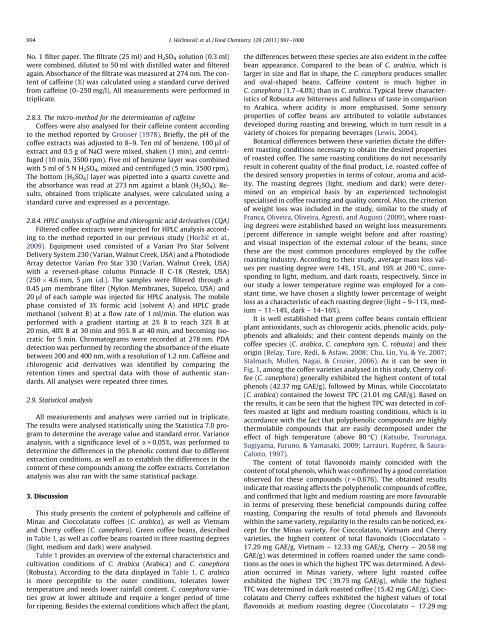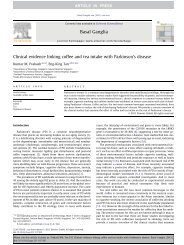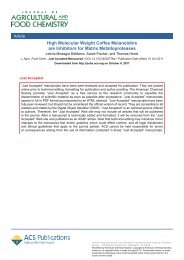Comparative study of polyphenols and caffeine in different coffee ...
Comparative study of polyphenols and caffeine in different coffee ...
Comparative study of polyphenols and caffeine in different coffee ...
You also want an ePaper? Increase the reach of your titles
YUMPU automatically turns print PDFs into web optimized ePapers that Google loves.
994 I. Hečimović et al. / Food Chemistry 129 (2011) 991–1000<br />
No. 1 filter paper. The filtrate (25 ml) <strong>and</strong> H2SO4 solution (0.3 ml)<br />
were comb<strong>in</strong>ed, diluted to 50 ml with distilled water <strong>and</strong> filtered<br />
aga<strong>in</strong>. Absorbance <strong>of</strong> the filtrate was measured at 274 nm. The content<br />
<strong>of</strong> <strong>caffe<strong>in</strong>e</strong> (%) was calculated us<strong>in</strong>g a st<strong>and</strong>ard curve derived<br />
from <strong>caffe<strong>in</strong>e</strong> (0–250 mg/l). All measurements were performed <strong>in</strong><br />
triplicate.<br />
2.8.3. The micro-method for the determ<strong>in</strong>ation <strong>of</strong> <strong>caffe<strong>in</strong>e</strong><br />
C<strong>of</strong>fees were also analysed for their <strong>caffe<strong>in</strong>e</strong> content accord<strong>in</strong>g<br />
to the method reported by Groisser (1978). Briefly, the pH <strong>of</strong> the<br />
c<strong>of</strong>fee extracts was adjusted to 8–9. Ten ml <strong>of</strong> benzene, 100 ll <strong>of</strong><br />
extract <strong>and</strong> 0.5 g <strong>of</strong> NaCl were mixed, shaken (1 m<strong>in</strong>), <strong>and</strong> centrifuged<br />
(10 m<strong>in</strong>, 3500 rpm). Five ml <strong>of</strong> benzene layer was comb<strong>in</strong>ed<br />
with 5 ml <strong>of</strong> 5 N H2SO4, mixed <strong>and</strong> centrifuged (5 m<strong>in</strong>, 3500 rpm).<br />
The bottom (H 2SO 4) layer was pipetted <strong>in</strong>to a quartz cuvette <strong>and</strong><br />
the absorbance was read at 273 nm aga<strong>in</strong>st a blank (H2SO4). Results,<br />
obta<strong>in</strong>ed from triplicate analyses, were calculated us<strong>in</strong>g a<br />
st<strong>and</strong>ard curve <strong>and</strong> expressed as a percentage.<br />
2.8.4. HPLC analysis <strong>of</strong> <strong>caffe<strong>in</strong>e</strong> <strong>and</strong> chlorogenic acid derivatives (CQA)<br />
Filtered c<strong>of</strong>fee extracts were <strong>in</strong>jected for HPLC analysis accord<strong>in</strong>g<br />
to the method reported <strong>in</strong> our previous <strong>study</strong> (Horzˇić et al.,<br />
2009). Equipment used consisted <strong>of</strong> a Varian Pro Star Solvent<br />
Delivery System 230 (Varian, Walnut Creek, USA) <strong>and</strong> a Photodiode<br />
Array detector Varian Pro Star 330 (Varian, Walnut Creek, USA)<br />
with a reversed-phase column P<strong>in</strong>nacle II C-18 (Restek, USA)<br />
(250 4.6 mm, 5 lm i.d.). The samples were filtered through a<br />
0.45 lm membrane filter (Nylon Membranes, Supelco, USA) <strong>and</strong><br />
20 ll <strong>of</strong> each sample was <strong>in</strong>jected for HPLC analysis. The mobile<br />
phase consisted <strong>of</strong> 3% formic acid (solvent A) <strong>and</strong> HPLC grade<br />
methanol (solvent B) at a flow rate <strong>of</strong> 1 ml/m<strong>in</strong>. The elution was<br />
performed with a gradient start<strong>in</strong>g at 2% B to reach 32% B at<br />
20 m<strong>in</strong>, 40% B at 30 m<strong>in</strong> <strong>and</strong> 95% B at 40 m<strong>in</strong>, <strong>and</strong> becom<strong>in</strong>g isocratic<br />
for 5 m<strong>in</strong>. Chromatograms were recorded at 278 nm. PDA<br />
detection was performed by record<strong>in</strong>g the absorbance <strong>of</strong> the eluate<br />
between 200 <strong>and</strong> 400 nm, with a resolution <strong>of</strong> 1.2 nm. Caffe<strong>in</strong>e <strong>and</strong><br />
chlorogenic acid derivatives was identified by compar<strong>in</strong>g the<br />
retention times <strong>and</strong> spectral data with those <strong>of</strong> authentic st<strong>and</strong>ards.<br />
All analyses were repeated three times.<br />
2.9. Statistical analysis<br />
All measurements <strong>and</strong> analyses were carried out <strong>in</strong> triplicate.<br />
The results were analysed statistically us<strong>in</strong>g the Statistica 7.0 program<br />
to determ<strong>in</strong>e the average value <strong>and</strong> st<strong>and</strong>ard error. Variance<br />
analysis, with a significance level <strong>of</strong> a = 0.05%, was performed to<br />
determ<strong>in</strong>e the differences <strong>in</strong> the phenolic content due to <strong>different</strong><br />
extraction conditions, as well as to establish the differences <strong>in</strong> the<br />
content <strong>of</strong> these compounds among the c<strong>of</strong>fee extracts. Correlation<br />
analysis was also ran with the same statistical package.<br />
3. Discussion<br />
This <strong>study</strong> presents the content <strong>of</strong> <strong>polyphenols</strong> <strong>and</strong> <strong>caffe<strong>in</strong>e</strong> <strong>of</strong><br />
M<strong>in</strong>as <strong>and</strong> Cioccolatato c<strong>of</strong>fees (C. arabica), as well as Vietnam<br />
<strong>and</strong> Cherry c<strong>of</strong>fees (C. canephora). Green c<strong>of</strong>fee beans, described<br />
<strong>in</strong> Table 1, as well as c<strong>of</strong>fee beans roasted <strong>in</strong> three roast<strong>in</strong>g degrees<br />
(light, medium <strong>and</strong> dark) were analysed.<br />
Table 1 provides an overview <strong>of</strong> the external characteristics <strong>and</strong><br />
cultivation conditions <strong>of</strong> C. Arabica (Arabica) <strong>and</strong> C. canephora<br />
(Robusta). Accord<strong>in</strong>g to the data displayed <strong>in</strong> Table 1, C. arabica<br />
is more perceptible to the outer conditions, tolerates lower<br />
temperature <strong>and</strong> needs lower ra<strong>in</strong>fall content. C. canephora varieties<br />
grow at lower altitude <strong>and</strong> require a longer period <strong>of</strong> time<br />
for ripen<strong>in</strong>g. Besides the external conditions which affect the plant,<br />
the differences between these species are also evident <strong>in</strong> the c<strong>of</strong>fee<br />
bean appearance. Compared to the bean <strong>of</strong> C. arabica, which is<br />
larger <strong>in</strong> size <strong>and</strong> flat <strong>in</strong> shape, the C. canephora produces smaller<br />
<strong>and</strong> oval-shaped beans. Caffe<strong>in</strong>e content is much higher <strong>in</strong><br />
C. canephora (1.7–4.0%) than <strong>in</strong> C. arabica. Typical brew characteristics<br />
<strong>of</strong> Robusta are bitterness <strong>and</strong> fullness <strong>of</strong> taste <strong>in</strong> comparison<br />
to Arabica, where acidity is more emphasised. Some sensory<br />
properties <strong>of</strong> c<strong>of</strong>fee beans are attributed to volatile substances<br />
developed dur<strong>in</strong>g roast<strong>in</strong>g <strong>and</strong> brew<strong>in</strong>g, which <strong>in</strong> turn result <strong>in</strong> a<br />
variety <strong>of</strong> choices for prepar<strong>in</strong>g beverages (Lewis, 2004).<br />
Botanical differences between these varieties dictate the <strong>different</strong><br />
roast<strong>in</strong>g conditions necessary to obta<strong>in</strong> the desired properties<br />
<strong>of</strong> roasted c<strong>of</strong>fee. The same roast<strong>in</strong>g conditions do not necessarily<br />
result <strong>in</strong> coherent quality <strong>of</strong> the f<strong>in</strong>al product, i.e. roasted c<strong>of</strong>fee <strong>of</strong><br />
the desired sensory properties <strong>in</strong> terms <strong>of</strong> colour, aroma <strong>and</strong> acidity.<br />
The roast<strong>in</strong>g degrees (light, medium <strong>and</strong> dark) were determ<strong>in</strong>ed<br />
on an empirical basis by an experienced technologist<br />
specialised <strong>in</strong> c<strong>of</strong>fee roast<strong>in</strong>g <strong>and</strong> quality control. Also, the criterion<br />
<strong>of</strong> weight loss was <strong>in</strong>cluded <strong>in</strong> the <strong>study</strong>, similar to the <strong>study</strong> <strong>of</strong><br />
Franca, Oliveira, Oliveira, Agresti, <strong>and</strong> Augusti (2009), where roast<strong>in</strong>g<br />
degrees were established based on weight loss measurements<br />
(percent difference <strong>in</strong> sample weight before <strong>and</strong> after roast<strong>in</strong>g)<br />
<strong>and</strong> visual <strong>in</strong>spection <strong>of</strong> the external colour <strong>of</strong> the beans, s<strong>in</strong>ce<br />
these are the most common procedures employed by the c<strong>of</strong>fee<br />
roast<strong>in</strong>g <strong>in</strong>dustry. Accord<strong>in</strong>g to their <strong>study</strong>, average mass loss values<br />
per roast<strong>in</strong>g degree were 14%, 15%, <strong>and</strong> 19% at 200 °C, correspond<strong>in</strong>g<br />
to light, medium, <strong>and</strong> dark roasts, respectively. S<strong>in</strong>ce <strong>in</strong><br />
our <strong>study</strong> a lower temperature regime was employed for a constant<br />
time, we have chosen a slightly lower percentage <strong>of</strong> weight<br />
loss as a characteristic <strong>of</strong> each roast<strong>in</strong>g degree (light – 9–11%, medium<br />
– 11–14%, dark – 14–16%).<br />
It is well established that green c<strong>of</strong>fee beans conta<strong>in</strong> efficient<br />
plant antioxidants, such as chlorogenic acids, phenolic acids, <strong>polyphenols</strong><br />
<strong>and</strong> alkaloids; <strong>and</strong> their content depends ma<strong>in</strong>ly on the<br />
c<strong>of</strong>fee species (C. arabica, C. canephora syn. C. robusta) <strong>and</strong> their<br />
orig<strong>in</strong> (Belay, Ture, Redi, & Asfaw, 2008; Chu, L<strong>in</strong>, Yu, & Ye, 2007;<br />
Stalmach, Mullen, Nagai, & Crozier, 2006). As it can be seen <strong>in</strong><br />
Fig. 1, among the c<strong>of</strong>fee varieties analysed <strong>in</strong> this <strong>study</strong>, Cherry c<strong>of</strong>fee<br />
(C. canephora) generally exhibited the highest content <strong>of</strong> total<br />
phenols (42.37 mg GAE/g), followed by M<strong>in</strong>as, while Cioccolatato<br />
(C. arabica) conta<strong>in</strong>ed the lowest TPC (21.01 mg GAE/g). Based on<br />
the results, it can be seen that the highest TPC was detected <strong>in</strong> c<strong>of</strong>fees<br />
roasted at light <strong>and</strong> medium roast<strong>in</strong>g conditions, which is <strong>in</strong><br />
accordance with the fact that polyphenolic compounds are highly<br />
thermolabile compounds that are easily decomposed under the<br />
effect <strong>of</strong> high temperature (above 80 °C) (Katsube, Tsurunaga,<br />
Sugiyama, Furuno, & Yamasaki, 2009; Larrauri, Rupérez, & Saura-<br />
Calixto, 1997).<br />
The content <strong>of</strong> total flavonoids ma<strong>in</strong>ly co<strong>in</strong>cided with the<br />
content <strong>of</strong> total phenols, which was confirmed by a good correlation<br />
observed for these compounds (r = 0.676). The obta<strong>in</strong>ed results<br />
<strong>in</strong>dicate that roast<strong>in</strong>g affects the polyphenolic compounds <strong>of</strong> c<strong>of</strong>fee,<br />
<strong>and</strong> confirmed that light <strong>and</strong> medium roast<strong>in</strong>g are more favourable<br />
<strong>in</strong> terms <strong>of</strong> preserv<strong>in</strong>g these beneficial compounds dur<strong>in</strong>g c<strong>of</strong>fee<br />
roast<strong>in</strong>g. Compar<strong>in</strong>g the results <strong>of</strong> total phenols <strong>and</strong> flavonoids<br />
with<strong>in</strong> the same variety, regularity <strong>in</strong> the results can be noticed, except<br />
for the M<strong>in</strong>as variety. For Cioccolatato, Vietnam <strong>and</strong> Cherry<br />
varieties, the highest content <strong>of</strong> total flavonoids (Cioccolatato –<br />
17.29 mg GAE/g, Vietnam – 12.33 mg GAE/g, Cherry – 20.58 mg<br />
GAE/g) was determ<strong>in</strong>ed <strong>in</strong> c<strong>of</strong>fees roasted under the same conditions<br />
as the ones <strong>in</strong> which the highest TPC was determ<strong>in</strong>ed. A deviation<br />
occurred <strong>in</strong> M<strong>in</strong>as variety, where light roasted c<strong>of</strong>fee<br />
exhibited the highest TPC (39.75 mg GAE/g), while the highest<br />
TFC was determ<strong>in</strong>ed <strong>in</strong> dark roasted c<strong>of</strong>fee (15.42 mg GAE/g). Cioccolatato<br />
<strong>and</strong> Cherry c<strong>of</strong>fees exhibited the highest values <strong>of</strong> total<br />
flavonoids at medium roast<strong>in</strong>g degree (Cioccolatato – 17.29 mg




